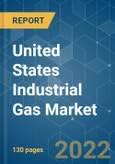The market for United States industrial gas is expected to grow at a CAGR of more than 4.5% globally during the forecast period. The resilient demand from the healthcare industry and growing prominence for specialty gases have been driving the market growth.
Key Highlights
- However, the environmental regulations and safety issues and the outbreak of COVID-19 disease across the globe are likely to hinder the growth of the studied market.
- Ramping up of Chemical and Petrochemical Industries in Gulf Coast and Texas is likely to provide opportunities for the United States industrial gas market over the next five years.
- The atmospheric gas segment is the most dominating gas type segment for the market studied.
Key Market Trends
Atmospheric Gas to Dominate the market
- The main atmospheric gases include oxygen, nitrogen, and argon, and the rare gasses that are then generally captured by lowering the air temperature until each component is liquefied and separable.
- Nitrogen, owing to its favorable qualities, has uses in heat treatment for the creation of a neutral atmosphere and in blast furnaces and many other furnaces use. Gas is now used on a wide scale in the healthcare industry, and the increasing health sector is expected to fuel business growth.
- Oxygen is used for processing, welding of steel, medical devices, smelting of copper, etc., it is believed to increase the thermal efficiency of fuel and can also be used to extract more energy from coal. As a result, the large-scale use of oxygen in various industries is expected to boost demand for industrial oxygen in the coming years.
- The above-mentioned factors are anticipated to drive the demand for atmospheric gas during the forecast period.
Resilient Demand from the Healthcare Industry
- The growth in the advancement of technology in the healthcare industry gives rise to the demand for the production of industrial gases, which, in turn, acts as a driving point for the industrial gas market.
- For example, the development of gas-assist equipment suppliers in the medical industry offers an assortment of equipment and controls, yet the fundamental procedure is comparative in all variations.
- In the medical industry, bulk oxygen is required in many cases to minimize the risk of excess oxygen in the lungs or body tissue during surgeries, and for providing artificial ventilation. Nitrogen is utilized in pre-flight lung diagnosis, to calculate a person’s ability to respond to a simulated aircraft cabin environment. Carbon dioxide can be used at the time of insufflation and can be infused with oxygen for stimulation of the respiratory simulation.
- The novel coronavirus (COVID-19) has made the need for medical gases even more acute in recent times. More than one million patients are treated with medical gases, such as oxygen, every day under prescription from a health care provider. Medical gases are administered in the emergency medical setting, the hospital setting, the outpatient setting, and in the home. Due to the importance of medical gases to treating COVID-19, medical gas manufacturing and distribution have been deemed “essential” by the federal government.
- According to the Centers for Disease Control and Prevention (CDC), almost 64% of the critically-ill patients treated for COVID-19 have received high-flow oxygen therapy and nearly 71% of patients received mechanical ventilation.
- According to the U.S. Food and Drug Administration (FDA), medical gases are manufactured at more than 4,000 manufacturing locations across the United States, the vast majority of which are small businesses. The manufacturing of medical gases is distributed across all 50 states to ensure that patients have access to critical medical gases in emergency settings, hospitals, outpatient clinics, and in their homes.
- Hence, all such market trends are expected to drive the demand for United States industrial gas market during the forecast period.
Competitive Landscape
The United States industrial gas market is consolidated in nature. Some of the major companies are Air Liquide, Air Products and Chemicals Inc., Linde PLC, Matheson Tri-Gas, Inc., and Messer North America, Inc. amongst others.
Additional Benefits:
- The market estimate (ME) sheet in Excel format
- 3 months of analyst support
This product will be delivered within 2 business days.
Table of Contents
Companies Mentioned (Partial List)
A selection of companies mentioned in this report includes, but is not limited to:
- Air Liquide
- Air Products and Chemicals Inc.
- AIR WATER INC
- Linde PLC
- Iwatani Corporation
- Matheson Tri-Gas, Inc.
- Messer North America, Inc.
- nexAir LLC.
- Taiyo Nippon Sanso Corporation
- UIG








